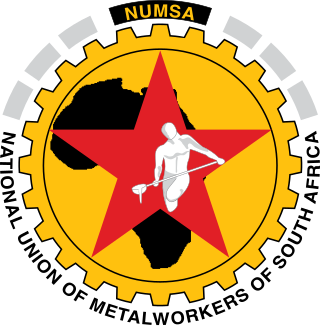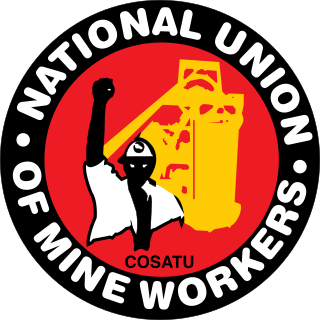Related Research Articles

IG Metall is the dominant metalworkers' union in Germany, making it the country's largest union as well as Europe's largest industrial union. Analysts of German labor relations consider it a major trend-setter in national bargaining.

The Congress of South African Trade Unions is a trade union federation in South Africa. It was founded in 1985 and is the largest of the country's three main trade union federations, with 21 affiliated trade unions.
Zwelinzima Vavi is the General Secretary of the South African Federation of Trade Unions (SAFTU). He is the former general secretary of the Congress of South African Trade Unions (COSATU), and vice-chairperson of the Millennium Labour Council.

The National Union of Metalworkers of South Africa (NUMSA) is the biggest single trade union in South Africa with more than 338,000 members, and prior to its expulsion on 8 November 2014, the largest affiliate of the Congress of South African Trade Unions (COSATU), the country's largest trade union federation.

The Food and Allied Workers Union (FAWU) is a trade union representing workers in the food processing industry in South Africa.

The National Union of Mineworkers (NUM) is a mainly mining industry related trade union, an organisation of workers with common goals through organised labour, in South Africa. With a membership of 300,000 as of 2014, it is the largest affiliate of the Congress of South African Trade Unions (COSATU).
Trade unions in South Africa has a history dating back to the 1880s. From the beginning unions could be viewed as a reflection of the racial disunity of the country, with the earliest unions being predominantly for white workers. Through the turbulent years of 1948–1991 trade unions played an important part in developing political and economic resistance, and eventually were one of the driving forces in realising the transition to an inclusive democratic government.

The Marikana massacre was the killing of thirty-four miners by the South African Police Service (SAPS) on 16 August 2012 during a six-week wildcat strike at the Lonmin platinum mine at Marikana near Rustenburg in South Africa's North West province. The massacre constituted the most lethal use of force by South African security forces against civilians since the Soweto uprising in 1976 and has been compared to the 1960 Sharpeville massacre.
The Western Cape 2012 Farm Workers' strike was a wave of strikes and protests by agricultural workers in the Western Cape from 27 August 2012 to 22 January 2013. The events led to the deaths of 3 workers, R160 million in damages as well as a 52% increase in the official minimum wage. The protests mostly took place the towns of De Doorns and Worcester with smaller protests in Ceres, Robertson, Grabouw, Wolseley and Villiersdorp. The main cause of the strikes was low worker pay of R69 per day and high unemployment.

The Workers and Socialist Party (WASP) is a Marxist and Trotskyist political party in South Africa affiliated to International Socialist Alternative.
On 15 November 2014 workers at South Africa's major platinum producers – Anglo American Platinum, Impala Platinum, and Lonmin – went on strike demanding that wages be immediately doubled. However, after five months of striking they settled for a more modest pay increase spread over three years. It was the longest and most expensive strike in South African history.
Irvin Jim is a South African trade union leader.
Zingiswa Phyllis Losi is a South African politician and trade unionist who is currently serving as the president of the Congress of South African Trade Unions (Cosatu) since September 2018. She was formerly Cosatu's second deputy president from 2009 to 2018. She is a member of the Central Committee of the South African Communist Party (SACP) and a former member of the National Executive Committee of the African National Congress (ANC).
The United Front was formally launched in South Africa in 2015, following a preparatory activities in 2014, including a summit in November of 350 delegates representing labour unions, social movements and popular organisations, faith-based organisations, NGOs and anti-capitalist formations. It was launched with the support of the National Union of Metalworkers of South Africa (NUMSA), which severed ties with the African National Congress and South African Communist Party at its December 2013 congress and to foster left-wing alternatives. While NUMSA defined itself as Marxist-Leninist, it envisaged the United Front as open to a range of forces, and as distinct from NUMSA itself. Significant differences of opinion emerged in the United Front from an early stage. The United Front effectively supplanted the Democratic Left Front, a smaller formation which had been established in 2011, itself founded following the collapse of the Anti-Privatisation Forum. Given the connection to NUMSA, both the Congress of South African Trade Unions (COSATU) which had expelled NUMSA, and the South African Communist Party, remained outside the United Front, the party proposing an alternative "left popular front" (LPF).

The Socialist Revolutionary Workers Party (SRWP) is a Marxist-Leninist communist party in South Africa. The party was founded in March 2019 after a pre-launch convention at the end of 2018.
The Liberated Metalworkers' Union of South Africa (LIMUSA) was a trade union representing workers in metal and related industries in South Africa.
The United Workers' Union of South Africa (UWUSA) was a general union in South Africa.

Workers of the German auto manufacturer Volkswagen Group are collectively organized and represented across a variety of worker organizations including trade unions and Works Councils across the globe. Workers are organized on multiple levels; locally, regionally, nationally, internationally and by marque.
Msokoli Frans Baleni is a South African businessman and former trade unionist who was general secretary of the National Union of Mineworkers between 2006 and 2015. Since 2007, he has been a member of the Central Committee of the South African Communist Party.
Vincent Mabuyakhulu was a South African politician and trade unionist from KwaZulu-Natal. He was Vice President of the National Union of Metalworkers of South Africa (Numsa), one of the largest affiliates of the Congress of South African Trade Unions (Cosatu). Later, he represented the African National Congress (ANC) in the National Assembly from May 2004 until his death in July 2006.
References
- 1 2 3 4 5 6 7 8 9 10 11 12 13 Roelf, Wendell (2021-10-14). "S.African engineering union rejects new wage offer, strike continues". Reuters . Retrieved 2021-10-15.
- 1 2 3 4 5 6 7 8 9 "South African car industry fears impact as union starts strike". Al Jazeera . 2021-10-05. Archived from the original on 2021-10-05. Retrieved 2021-10-15.
- 1 2 3 4 5 6 7 8 9 10 11 12 13 Martin, Patrick (2021-10-06). "Massive strike by steelworkers in South Africa". World Socialist Web Site . Archived from the original on 2021-10-07. Retrieved 2021-10-15.
- 1 2 3 "South African union accepts wage offer, paving way for strike to end". Reuters . 2021-10-21. Retrieved 2021-10-22.
- 1 2 3 4 Njini, Felix (2021-10-21). "South African Steelworkers Accept New Pay Deal to End Strike". Bloomberg News . Archived from the original on 2021-10-22. Retrieved 2021-10-22.
- 1 2 3 4 Martin, Patrick (2021-10-21). "South Africa union calls off metalworkers' strike". World Socialist Web Site . Archived from the original on 2021-10-22. Retrieved 2021-10-22.